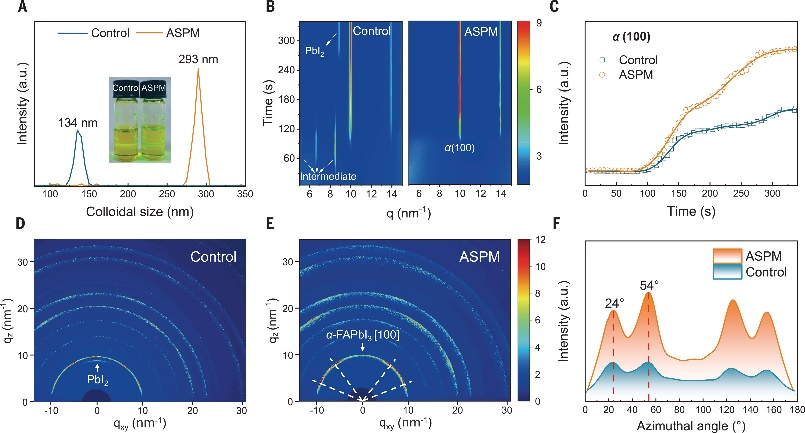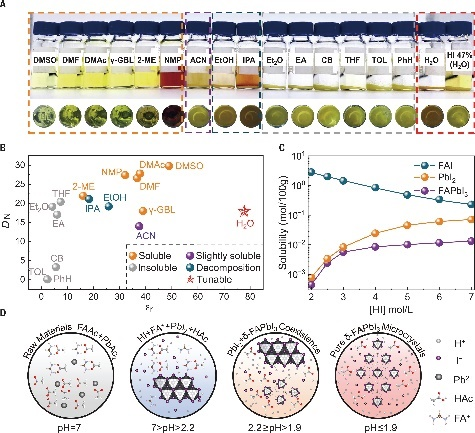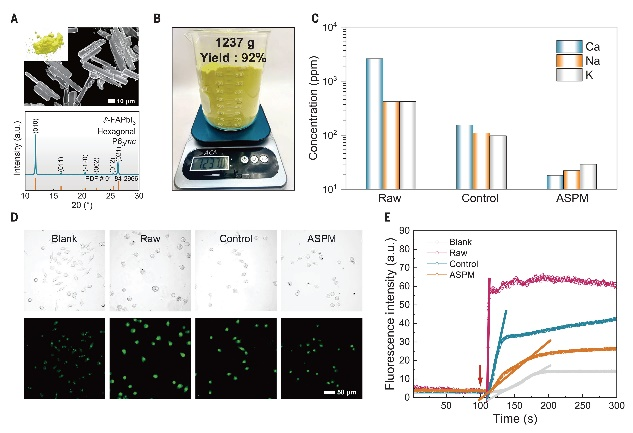Researchers used BL17B synchrotron-based in-situ GIWAXS to analyze the crystallization kinetics of the as-coated perovskite solution under annealing with various precursor solution conditions, thereby providing important experimental basis for revealing the structure-function relationship between precursor solutions and the crystallization mechanism of perovskite films.

Aqueous synthesis of perovskite precursors for highly efficient perovskite solar cells
Scientific Achievement
The research team from Southern University of Science and Technology, comprising Baomin Xu, Yong Zhang, and Xingzhu Wang, present aqueous synthesized perovskite microcrystals as precursor materials for perovskite solar cells (PSCs). This synthesis approach enables kilogram-scale mass production and synthesizes formamidinium lead iodide (FAPbI3) microcrystals with up to 99.996% purity, with an average value of 99.994 ± 0.0015%, from inexpensive, low-purity raw materials. With these purified precursors, we achieved a power conversion efficiency (PCE) of 25.6% (25.3% certified) in inverted PSCs and retained 94% of the initial PCE after 1000 hours of continuous simulated solar illumination. Their research findings, titled "Aqueous synthesis of perovskite precursors for highly efficient perovskite solar cells," were published in Science in February 2024.
Significance and Impact
The research has made a remarkable breakthrough in the field of high-efficiency perovskite solar cells, successfully developing an aqueous synthesis approach of perovskite microcrystals as PSCs precursors. It has also unveiled the purification mechanism of aqueous synthesis perovskite crystals, thereby providing significant support for the fabrication of efficient solar cells at substantially reduced raw material costs.
Research background
Although perovskite solar cells (PSCs) offer the potential for low-cost fabrication and high power conversion efficiency (PCE), defects in the perovskite layer have been a major challenge to achieve high PCEs. Precursor quality plays a crucial role in addressing these challenges, with high-purity precursor materials demonstrating considerable potential in minimizing the impurity-induced intrinsic defects. Thus, finding ways to remove precursor impurities, along with a better understanding of the effects of impurities, could improve PSCs performance.
Main research contents
Researchers developed an aqueous synthesis approach of perovskite microcrystals as precursor for highly efficient PSCs, established criteria for solvent selection in perovskite crystal synthesis, and introduced an evaluation method for raw materials used in producing perovskite crystal. They also revealed the purification mechanism of aqueous synthesis perovskite crystals, demonstrating that the aqueous solution effectively removes impurities such as calcium, sodium, and potassium ions, which is crucial for enhancing crystal purity. Removal of these ions led to a reduced defect density and extension of carrier diffusion length within the resultant perovskite film, which contributed to the superior performance of PSCs.

Fig. 1. Aqueous synthesis of FAPbI3 perovskite microcrystals.

Fig. 2. The purification of aqueous synthesized perovskite microcrystals.
附件下载:
